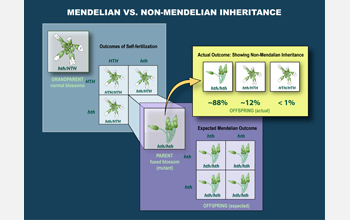Multimedia Gallery
Reappearance of Missing Genetic Information (Image 2)
Any particular gene in an organism may have alternative variations, as is the case of the "hothead" gene in Arabidopsis thaliana. Knowing the genetic variations of the parents allows us to predict the physical description of their prodigy if the genes are passed on according to the basic tenets of Mendelian genetics.
Gregor Mendel's first law, the "Principle of Segregation," asserts that hereditary characteristics are determined by genes appearing in pairs. Usually one of the pair comes from each parent. But this plant fertilizes itself, so if a normal hothead gene (abbreviated HTH) is present at all, the plant forms normal blossoms. If the plant has two copies of the mutated hothead gene (abbreviated hth) the plant's blossoms are fused. Therefore, three genetic combinations are possible: HTH/HTH, HTH/hth, and hth/hth. These yield normal, normal, and fused blossoms, respectively.
The observed genetic inheritance of the hothead gene, however, challenges Mendel's first law. The actual outcome of three generations of plant breeding, shown on the right, illustrates the reappearance of normal flowers in the offspring generation. But the parent plant (middle box) seemingly has no HTH copy of the hothead gene to pass on. Therefore, traditional genetic theory may need modification.
This image accompanied NSF press release, "Reappearance of Missing Genetic Information Poses Exception to the Rule." [See related image Here.]
Credit: Zina Deretsky, National Science Foundation
Images and other media in the National Science Foundation Multimedia Gallery are available for use in print and electronic material by NSF employees, members of the media, university staff, teachers and the general public. All media in the gallery are intended for personal, educational and nonprofit/non-commercial use only.
Images credited to the National Science Foundation, a federal agency, are in the public domain. The images were created by employees of the United States Government as part of their official duties or prepared by contractors as "works for hire" for NSF. You may freely use NSF-credited images and, at your discretion, credit NSF with a "Courtesy: National Science Foundation" notation.
Additional information about general usage can be found in Conditions.
Also Available:
Download the high-resolution JPG version of the image. (1.4 MB)
Use your mouse to right-click (Mac users may need to Ctrl-click) the link above and choose the option that will save the file or target to your computer.

